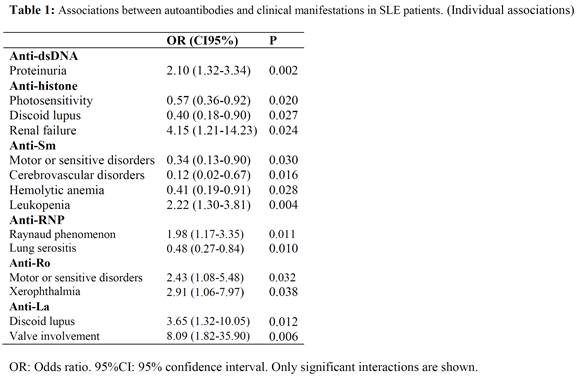Session Information
Date: Sunday, November 8, 2015
Title: Systemic Lupus Erythematosus - Clinical Aspects and Treatment Poster Session I
Session Type: ACR Poster Session A
Session Time: 9:00AM-11:00AM
Background/Purpose: Analyses of the association between autoantibodies and SLE clinical
manifestations using cluster analyses assume that centroid and within-cluster
residuals are similar inside the cluster and different between clusters. However,
these antibodies and their combinations within a cluster may have different clinical
impact; moreover, the residuals of two clusters may not be different enough
leading to incorrect conclusions. We have therefore evaluated these associations
individually and in combinations overcoming the problems noted above.
Methods: Patients with available data for anti-dsDNA, anti-histone, anti-Sm,
anti-RNP, anti-Ro and anti-La from a multinational SLE cohort were included.
Autoantibodies were evaluated individually and in pre-specified combinations (anti-dsDNA
+ anti-histone; anti-Sm + anti-RNP; anti-Ro + anti-La). About 100 clinical
manifestations were systematically recorded using a common protocol. Logistic
regressions were used to examine the association between autoantibodies and clinical
manifestations and components of the last SLICC/ACR Damage Index (SDI) and a
Poisson regression with the last total SDI.
Results: Three hundred and thirty-eight patients representative of the entire
cohort (n=1480) other than for their ethnic distribution (50.6% vs. 38.1%, Caucasians;
37.9% vs. 45.3%, Mestizo and 11.5% vs. 16.6%, others p=0.001) were studied.
Of them, 329 (97.3%) fulfilled ≥4ACR criteria. Mean age at diagnosis was 28.5
(SD: 11.5) years, 308 (91.1%) were female; follow-up was 4.6 (1.7) years. Baseline
SLEDAI was 10.5 (7.6) and baseline SDI was 1.0 (1.3). The associations between
clinical manifestations and autoantibodies are depicted in Tables 1 and 2. The
associations between autoantibodies and the last SDI and its components are
depicted in Table 3.
Conclusion: Autoantibodies profiles are associated with different manifestations
and damage among SLE patients. Anti-histone positivity, among anti-dsDNA
positive patients and anti-La positivity were associated with damage accrual,
but anti-Sm positivity among anti-RNP negative patients was negatively
associated with damage accrual. The interaction between autoantibodies should
be evaluated in larger populations in order to evaluate less frequent
manifestations.
To cite this abstract in AMA style:
Ugarte-Gil M, Wojdyla D, Garcia-Valladares I, Gamboa-Cardenas RV, Gonzalez-Bello Y, Pons-Estel GJ, Pastor-Asurza CA, Garcia-De La Torre I, Alarcon GS, Pons-Estel B. Associations Between Autoantibodies and Clinical Manifestations in Systemic Lupus Erythematosus: Data from a Multiethnic Latin American Cohort [abstract]. Arthritis Rheumatol. 2015; 67 (suppl 10). https://acrabstracts.org/abstract/associations-between-autoantibodies-and-clinical-manifestations-in-systemic-lupus-erythematosus-data-from-a-multiethnic-latin-american-cohort/. Accessed .« Back to 2015 ACR/ARHP Annual Meeting
ACR Meeting Abstracts - https://acrabstracts.org/abstract/associations-between-autoantibodies-and-clinical-manifestations-in-systemic-lupus-erythematosus-data-from-a-multiethnic-latin-american-cohort/



